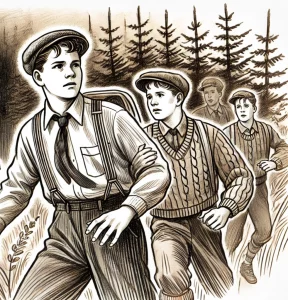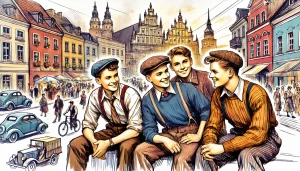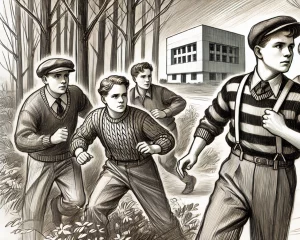The Incredible Escape from Auschwitz-Birkenau: The Story of Four Brave Boys
 Imagine being a teenager, torn from your family and thrust into one of the most horrific places in history. This was the reality for Arie Auerbacher, Shmuel Erlich, Shmuel Lezner, and Yechiel Eisenbach. Yet, in 1944, these four boys did the unimaginable—they escaped from Auschwitz-Birkenau, defying the odds and securing their place in history as symbols of courage and resilience.
Imagine being a teenager, torn from your family and thrust into one of the most horrific places in history. This was the reality for Arie Auerbacher, Shmuel Erlich, Shmuel Lezner, and Yechiel Eisenbach. Yet, in 1944, these four boys did the unimaginable—they escaped from Auschwitz-Birkenau, defying the odds and securing their place in history as symbols of courage and resilience.
In the heart of Nazi-occupied Poland, Auschwitz-Birkenau stood as a symbol of terror and death. Amidst the unimaginable horrors, a glimmer of hope emerged through the daring escape of four young boys. How did they manage to break free from the most notorious death camp of World War II? This is their story.
Life in an Extermination Camp
Auschwitz-Birkenau, the largest of the Nazi concentration and extermination camps, was operational from 1940 to 1945. Designed to systematically annihilate millions, primarily Jews, but also Poles, Romani people, Soviet prisoners of war, and others deemed undesirable by the Nazi regime, the camp became a symbol of the Holocaust’s brutality.
Daily Life and Conditions
Prisoners at Auschwitz faced brutal conditions. They were packed into overcrowded barracks, often with hundreds of people crammed into spaces meant for a fraction of that number. The barracks were cold, damp, and infested with rats and lice. Sanitation was almost nonexistent, leading to rampant disease.
Prisoners were subjected to grueling forced labor, working in nearby factories, quarries, and fields for up to 12 hours a day. Malnutrition was rampant; inmates were given minimal food—watery soup, a slice of bread, and occasionally a small piece of margarine or sausage. Starvation and overwork claimed many lives.
Constant Fear and Brutality
The constant threat of death loomed over every prisoner. Selections for the gas chambers were a frequent occurrence, and anyone deemed unfit for work was sent to die. The gas chambers themselves were a horrifying reality, with thousands murdered daily in a process designed for maximum efficiency and terror.
Profiles of Courage
 Born in 1930 in Germany, Arie Auerbacher was just a child when the Nazis began their campaign against Jews. His family was deported to Theresienstadt, a transit camp, before being sent to Auschwitz in 1944. At Auschwitz, Arie was separated from his family and forced into the children’s barracks. Despite the brutal conditions, he managed to hold onto hope, drawing strength from memories of his family and his faith, thinking about escaping from Auschwitz.
Born in 1930 in Germany, Arie Auerbacher was just a child when the Nazis began their campaign against Jews. His family was deported to Theresienstadt, a transit camp, before being sent to Auschwitz in 1944. At Auschwitz, Arie was separated from his family and forced into the children’s barracks. Despite the brutal conditions, he managed to hold onto hope, drawing strength from memories of his family and his faith, thinking about escaping from Auschwitz.
Shmuel Erlich, born in 1929 in Poland, witnessed the destruction of his community during the Nazi invasion. He and his family were forced into the ghettos before being deported to Auschwitz. At the camp, Shmuel was torn from his family and subjected to forced labor. His sharp intellect and quick thinking helped him survive the selection process multiple times, and he became adept at finding ways to secure extra food and avoid the most dangerous work assignments.
Shmuel Lezner, also from Poland, was born in 1928. His family’s deportation to Auschwitz marked the end of a childhood filled with love and community. In the camp, Shmuel was known for his resilience and courage. Despite being surrounded by death and despair, he remained determined to survive. Shmuel became part of a small group of prisoners who secretly organized resistance efforts within the camp, providing him with critical knowledge that would later aid in his escape.
Yechiel Eisenbach, born in 1931 in Hungary, faced the horrors of Auschwitz with a fierce will to survive. Deported with his family in 1944, he quickly learned to navigate the brutal environment of the camp. Yechiel’s resourcefulness was evident in how he managed to avoid selections and find small acts of kindness, such as sharing food or information, that made a significant difference in the lives of fellow prisoners. His ability to stay positive under such dire circumstances inspired those around him.
Did You Know?
Successful escapes from Auschwitz-Birkenau were incredibly rare. Out of the estimated 1.3 million people deported to the camp, fewer than 150 managed to escape. The escape of Arie, Shmuel E., Shmuel L., and Yechiel stands out not only because of their youth but also due to the meticulous planning and sheer bravery involved.
The Great Escape
 The boys’ escape from Auschwitz-Birkenau was not a spur-of-the-moment decision. It involved careful planning, stealth, and an incredible amount of bravery. They had to gather information about the camp’s layout, identify the best time to escape, and find disguises or hideouts to avoid detection.
The boys’ escape from Auschwitz-Birkenau was not a spur-of-the-moment decision. It involved careful planning, stealth, and an incredible amount of bravery. They had to gather information about the camp’s layout, identify the best time to escape, and find disguises or hideouts to avoid detection.
On the day of their escape, they managed to slip past guards, navigate the electrified fences, and avoid the patrols that constantly scoured the camp’s perimeter. Each step was fraught with danger, and one misstep could have led to their capture or death. Yet, through their combined efforts and unwavering determination, they succeeded in breaking free from the death camp.
The Aftermath and Legacy
After their escape, the boys faced a long and perilous journey to safety. They had to evade Nazi patrols, find food and shelter, and make their way through war-torn Europe. Their survival depended on their resourcefulness and the occasional help of strangers who risked their lives to aid them.
The impact of their escape was profound. It served as a beacon of hope to other prisoners and a testament to the human spirit’s ability to overcome even the most harrowing circumstances. After the war, each of the boys went on to rebuild their lives, contributing to society in various ways and sharing their stories to ensure that the horrors of the Holocaust would never be forgotten.
Reflections and Historical Analysis
As adults, the boys reflected on their harrowing journey and the impact it had on their lives. Arie Auerbacher became a renowned author and speaker, sharing his experiences to educate others about the Holocaust. Shmuel Erlich pursued a career in psychology, helping others overcome trauma. Shmuel Lezner and Yechiel Eisenbach also found ways to contribute to their communities, never forgetting the lessons of resilience and courage they learned during the war.
Historians view the escape of these four boys as a remarkable feat of bravery and ingenuity. It highlights the extraordinary lengths to which individuals would go to resist oppression and seek freedom. Their story is not just a tale of survival but a powerful reminder of the resilience of the human spirit.
The escape of Arie Auerbacher, Shmuel Erlich, Shmuel Lezner, and Yechiel Eisenbach from Auschwitz-Birkenau is a story of unparalleled bravery and resilience. Their journey from the horrors of the death camp to freedom is a testament to the strength of the human spirit. As historian Michael Berenbaum aptly put it, “Their escape is a powerful reminder that even in the darkest times, hope and courage can prevail.”
Find Out More!
For those interested in learning more about this incredible story, here are three recommended sources:
- Books::
– “Survivors: True Stories of Children in the Holocaust” by Allan Zullo and Mara Bovsun
– “Night” by Elie Wiesel
- Websites:
– United States Holocaust Memorial Museum
0 Comments